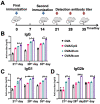A spontaneous multifunctional hydrogel vaccine amplifies the innate immune response to launch a powerful antitumor adaptive immune response
- PMID: 34093863
- PMCID: PMC8171104
- DOI: 10.7150/thno.58173
A spontaneous multifunctional hydrogel vaccine amplifies the innate immune response to launch a powerful antitumor adaptive immune response
Abstract
Substantial progress has been made with cancer immunotherapeutic strategies in recent years, most of which mainly rely on enhancing the T cell response. However, sufficient tumor antigen information often cannot be presented to T cells, resulting in a failed effector T cell response. The innate immune system can effectively recognize tumor antigens and then initiate an adaptive immune response. Here, we developed a spontaneous multifunctional hydrogel (NOCC-CpG/OX-M, Ncom Gel) vaccine to amplify the innate immune response and harness innate immunity to launch and maintain a powerful adaptive immune response. Methods: Ncom Gel was formed by a Schiff base reaction between CpG-modified carboxymethyl chitosan (NOCC-CpG) and partially oxidized mannan (OX-M). The effects of the Ncom Gel vaccine on DCs and macrophages in vitro and antigen-specific humoral immunity and cellular immunity in vivo were studied. Furthermore, the antitumor immune response of the Ncom Gel vaccine and its effect on the tumor microenvironment were evaluated. Results: The Ncom Gel vaccine enhanced antigen presentation to T cells by facilitating DC uptake and maturation and inducing macrophages to a proinflammatory subtype, further leading to a T cell-mediated adaptive immune response. Moreover, the innate immune response could be amplified via the promotion of antigen-specific antibody production. The Ncom Gel vaccine reversed the tumor immune microenvironment to an inflamed phenotype and showed a significant antitumor response in a melanoma model. Conclusions: Our research implies the potential application of injectable hydrogels as a platform for tumor immunotherapy. The strategy also opens up a new avenue for multilayered cancer immunotherapy.
Keywords: Ncom Gel vaccine; adaptive immune response; cancer immunotherapy; innate immunity; spontaneous multifunctional hydrogel.
© The author(s).
Conflict of interest statement
Competing Interests: The authors have declared that no competing interest exists.
Figures








Similar articles
-
A Multi-Functional Nanoadjuvant Coupling Manganese with Toll-Like 9 Agonist Stimulates Potent Innate and Adaptive Anti-Tumor Immunity.Adv Sci (Weinh). 2024 Nov;11(41):e2402678. doi: 10.1002/advs.202402678. Epub 2024 Sep 11. Adv Sci (Weinh). 2024. PMID: 39258810 Free PMC article.
-
Injectable polypeptide hydrogel-based co-delivery of vaccine and immune checkpoint inhibitors improves tumor immunotherapy.Theranostics. 2019 Apr 12;9(8):2299-2314. doi: 10.7150/thno.30577. eCollection 2019. Theranostics. 2019. PMID: 31149045 Free PMC article.
-
Nanostructured lipid carriers based mRNA vaccine leads to a T cell-inflamed tumour microenvironment favourable for improving PD-1/PD-L1 blocking therapy and long-term immunity in a cold tumour model.EBioMedicine. 2025 Feb;112:105543. doi: 10.1016/j.ebiom.2024.105543. Epub 2025 Jan 9. EBioMedicine. 2025. PMID: 39793480 Free PMC article.
-
Empowering dendritic cell cancer vaccination: the role of combinatorial strategies.Cytotherapy. 2018 Nov;20(11):1309-1323. doi: 10.1016/j.jcyt.2018.09.007. Epub 2018 Oct 22. Cytotherapy. 2018. PMID: 30360963 Review.
-
Dendritic Cells, the T-cell-inflamed Tumor Microenvironment, and Immunotherapy Treatment Response.Clin Cancer Res. 2020 Aug 1;26(15):3901-3907. doi: 10.1158/1078-0432.CCR-19-1321. Epub 2020 Apr 24. Clin Cancer Res. 2020. PMID: 32332013 Free PMC article. Review.
Cited by
-
Reversing cancer immunoediting phases with a tumor-activated and optically reinforced immunoscaffold.Bioact Mater. 2024 Feb 3;35:228-241. doi: 10.1016/j.bioactmat.2024.01.026. eCollection 2024 May. Bioact Mater. 2024. PMID: 38333614 Free PMC article.
-
Breaking the Tumor Chronic Inflammation Balance with a Programmable Release and Multi-Stimulation Engineering Scaffold for Potent Immunotherapy.Adv Sci (Weinh). 2024 Jul;11(28):e2401377. doi: 10.1002/advs.202401377. Epub 2024 May 17. Adv Sci (Weinh). 2024. PMID: 38760901 Free PMC article.
-
Self-sufficient nanoparticles with dual-enzyme activity trigger radical storms and activate cascade-amplified antitumor immunologic responses.Acta Pharm Sin B. 2024 Feb;14(2):821-835. doi: 10.1016/j.apsb.2023.10.003. Epub 2023 Oct 18. Acta Pharm Sin B. 2024. PMID: 38322329 Free PMC article.
-
I n situ tumor vaccine with optimized nanoadjuvants and lymph node targeting capacity to treat ovarian cancer and metastases.Acta Pharm Sin B. 2024 Sep;14(9):4102-4117. doi: 10.1016/j.apsb.2024.06.003. Epub 2024 Jun 8. Acta Pharm Sin B. 2024. PMID: 39309485 Free PMC article.
-
Optimized DOX Drug Deliveries via Chitosan-Mediated Nanoparticles and Stimuli Responses in Cancer Chemotherapy: A Review.Molecules. 2023 Dec 20;29(1):31. doi: 10.3390/molecules29010031. Molecules. 2023. PMID: 38202616 Free PMC article. Review.
References
-
- Galon J, Bruni D. Approaches to treat immune hot, altered and cold tumours with combination immunotherapies. Nat Rev Drug Discov. 2019;18:197–218. - PubMed
-
- Phuengkham H, Ren L, Shin IW, Lim YT. Nanoengineered immune niches for reprogramming the immunosuppressive tumor microenvironment and enhancing cancer immunotherapy. Adv Mater. 2019;31:1803322. - PubMed
Publication types
MeSH terms
Substances
LinkOut - more resources
Full Text Sources
Medical

